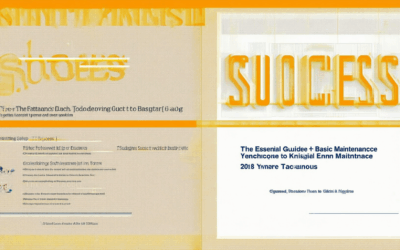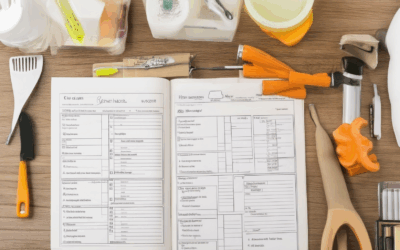Organizing a monthly care schedule can transform your life, ensuring your home remains clean, well-maintained, and safe year-round. Whether you’re managing a household, running a business, or caring for a property, a structured monthly care plan is essential for efficiency and long-term success. This comprehensive guide will walk you through everything you need to know, from essential tasks to optional add-ons, helping you create a personalized routine that fits your unique needs. By following the tips and strategies outlined in this article, you’ll not only save time but also enhance the overall condition of your space. From monthly cleaning schedules to home maintenance plans, we’ve got you covered. Read on to discover how to craft a routine that works for you and your family.
Key Takeaways
- Organize a monthly home maintenance schedule to keep your house in top shape and ensure regular checks.
- Identify key areas such as plumbing, HVAC, and utilities to maintain optimal functionality.
- Assign task frequencies – monthly, quarterly, and annual checks to address different needs.
- Create a checklist tailored to your home’s unique requirements for efficient maintenance.
- Prioritize tasks to handle urgent issues first, like fixing leaks or addressing electrical problems.
- Understand the benefits: Regular maintenance prevents costly repairs, extends your home’s lifespan, ensures safety, and saves time.
- Use the right tools for inspections and fixes, ensuring you have the necessary equipment ready.
- Leverage apps like Sam’s Maintenance for streamlined scheduling and task management.
- Set up a maintenance plan with clear steps and organization to keep your property in excellent condition.

Monthly Cleaning Schedule
Keeping your home clean and organized doesn’t have to be overwhelming with a well-planned monthly cleaning schedule. Here’s a comprehensive guide to help you stay on top of your chores:
1. Floor Care
- Vacuum all carpets, rugs, and upholstery.
- Mop hard floors (tile, wood, laminate).
- Spot clean stains or spills immediately.
- Dust mop corners and baseboards.
2. Bathroom Cleaning
- Scrub tiles and grout with a mild cleaner.
- Clean mirrors, shower doors, and windows.
- Wash shower walls and tiles.
- Check for and fix any plumbing leaks.
3. Kitchen Cleaning
- Clean countertops, sinks, and appliances.
- Wipe down all cabinetry and handles.
- Empty and clean trash cans.
- Check food expiration dates and discard expired items.
- Organize pantry shelves.
4. Living Room & Bedroom Cleaning
- Dust all surfaces, including ceiling fans and light fixtures.
- Wipe down window sills and shelves.
- Fluff and wash throw pillows and blankets.
- Vacuum under beds and furniture.
5. Outdoor Maintenance
- Clean gutters and downspouts, removing debris.
- Trim grass, weeds, and bushes.
- Prune trees and shrubs.
- Inspect the roof for missing shingles or damaged flashing.
6. Window Cleaning
- Clean interior and exterior of all windows.
- Check window screens for tears or holes.
For a deeper clean, consider tackling one room or area each week. Regular cleaning helps maintain a fresh environment and prevents small messes from becoming big problems. Keep a cleaning caddy handy with essentials like microfiber cloths, all-purpose cleaner, and a vacuum!
What is a monthly schedule?
A monthly schedule is a detailed and organized plan that helps you manage your time effectively by outlining all essential tasks, events, and responsibilities for the entire month. It serves as a roadmap to stay focused, productive, and ahead of deadlines while maintaining balance in your personal and professional life.
Benefits of Creating a Monthly Schedule
- Clarity : Helps you visualize your priorities and commitments.
- Reduced Stress : Minimizes last-minute rushes and overwhelming tasks.
- Improved Productivity : Ensures consistent progress toward your goals.
- Better Time Management : Allows you to allocate time wisely for work, family, and leisure activities.
Steps to Create an Effective Monthly Schedule
1. Plan Your Month
- Review your calendar and identify key dates, deadlines, and recurring events.
- Assess your responsibilities, both personal and professional.
- Set realistic goals and prioritize tasks based on importance and urgency.
2. Organize Your Tasks
- Categorize your tasks into daily, weekly, and monthly activities.
- Use tools like digital calendars or task management apps to track your progress.
- Incorporate breaks and downtime to maintain mental health and productivity.
3. Review and Adjust
- Regularly check your schedule to ensure alignment with your goals.
- Flexibility is key; adjust your plan as needed due to changes in priorities or unexpected events.
- Reflect on what worked well and what needs improvement at the end of each month.
4. Track Progress
- Use checklists or journals to monitor your achievements and identify gaps.
- Stay accountable by sharing your schedule with trusted individuals or mentors.
- Celebrate milestones to stay motivated and recognize your efforts.
By following these steps, you can create a monthly schedule that works for you, helping you stay organized and achieve your objectives efficiently.

How to Plan a Monthly Schedule
To effectively plan a monthly schedule, follow these organized steps:
- Set Clear Goals : Begin by defining your objectives for the month. Identify personal, professional, and household tasks to guide your planning.
- Prioritize Tasks : Categorize tasks by urgency and importance. Use techniques like the Eisenhower Matrix to sort them into quadrants, focusing on critical and high-priority tasks.
- Time Block : Allocate specific time slots for each task. Allocated time ensures tasks are addressed without overlap. Consider your most productive hours for task completion.
- Mark Key Dates : Highlight important events, deadlines, and personal milestones on your calendar. These fixed points provide structure and prevent overlook.
- Buffer Time : Incorporate short breaks between tasks to avoid burnout. Allow flexibility for unexpected occurrences, ensuring a balanced schedule.
- Adapt to Energy Levels : Schedule tasks according to your peak productivity times. Adjust activities to align with your energy cycles, optimizing efficiency.
- Review and Adjust : Conduct weekly reviews to evaluate progress and adjust the schedule as needed. Flexibility is crucial, allowing for changes without derailing your plan.
- Incorporate Fun and Relaxation : Dedicate specific days or times for hobbies and social activities. Balance is essential for maintaining well-being.
- Organize Recurring Tasks : Group similar tasks together to streamline processes and reduce decision fatigue. Utilize tools like planners or digital calendars for ease.
- Consider Dependencies : Acknowledge task dependencies and schedule accordingly. Anticipate these to prevent delays and overlaps.
- Stay Organized and Flexible : Embrace imperfection; adjustments are part of the planning process. Maintain a structure that adapts to life’s unpredictability.
By following these steps, you can create a monthly schedule that is both structured and adaptable, supporting your productivity and overall well-being.

How to Create a Home Maintenance Schedule
To keep your home in great shape, creating a regular maintenance schedule is essential. Below is a comprehensive guide to help you organize and manage your home maintenance tasks effectively.
Step-by-Step Guide to Creating Your Home Maintenance Schedule
- 1. Identify Key Areas to Maintain: – Plumbing System : Check pipes for leaks, test water pressure, and inspect the water heater. – Electrical System : Examine switches, sockets, and wiring for damage or wear. – Heating, Ventilation & Air Conditioning (HVAC) : Clean vents, check ductwork, and service the furnace or AC unit. – Exterior : Inspect roof, gutters, siding, and fences for damage or decay. – Appliances : Clean and maintain cooking appliances, refrigerators, and laundry machines. – Landscaping : Trim trees, bushes, and lawn, and clean gutters. – Fire Safety : Test smoke detectors and fire extinguishers. – Utilities : Check for leaks in pipes, water heaters, and gas lines.
- 2. Assign Task Frequencies: – Monthly Tasks : Check for leaks, clean gutters, test smoke detectors, and change air filters. – Quarterly Tasks : Inspect plumbing, electrical systems, and HVAC units. – Annually : Examine the roof, siding, fences, and major appliances.
- 3. Create a Checklist: – Develop a simple checklist tailored to your home’s unique needs. – Include a list of required tools, such as a screwdriver, wrench, multimeter, and flashlight.
- 4. Prioritize Tasks: – Tackle urgent tasks first, such as fixing leaks or addressing electrical issues. – Schedule less critical tasks for slower periods.
- 5. Stay Consistent: – Stick to your schedule to ensure ongoing maintenance and prevention of minor issues from becoming major problems.
Benefits of Regular Home Maintenance
- Prevents costly repairs
- Extends the lifespan of your home
- Ensures safety and functionality
- Saves time and effort
Tools You’ll Need
- Screwdriver
- Wrench
- Multimeter
- Flashlight
- Garden gloves
- Protective eyewear
- Basic tool kit
By following this maintenance schedule, you can ensure your home remains in excellent condition year-round. Regular checks and timely repairs will save you time, money, and stress in the long run.
What is the App for Home Maintenance Schedule?
Sam’s Maintenance offers a comprehensive digital tool tailored for homeowners seeking to streamline their home maintenance routines. This app provides a customizable calendar and task management system designed to keep track of essential chores and maintenance tasks, ensuring nothing is overlooked.
Key Features:
- Scheduling Made Easy: Create and organize maintenance schedules with drag-and-drop functionality, making it simple to plan and execute tasks.
- Reminders and Notifications: Set reminders for upcoming tasks to stay on top of your home maintenance schedule.
- Task List Management: Add recurring or one-time tasks, categorize them, and assign due dates to keep everything organized.
- Progress Tracking: Mark tasks as completed to monitor your home’s maintenance status and ensure everything runs smoothly.
- Integration Capabilities: Sync with other apps like Google Calendar or third-party services to centralize your home maintenance routine.
Leverage Sam’s Maintenance features to optimize your home maintenance schedule and enjoy peace of mind knowing your property is well-maintained. Start your free trial today and experience the difference a personalized maintenance plan can make!

How to Set Up a Maintenance Schedule
To establish an effective maintenance schedule for your property, follow these organized steps:
- Assess Your Property
- Inspect the exterior for issues like missing shingles or gutters needing cleaning.
- Check the interior for signs of wear, such as leaky pipes or outdated appliances.
- Examine the lawn and garden for necessary pruning or seeding.
- Monthly Tasks: Change HVAC filters, mow the lawn, trim trees, and clean gutters.
- Quarterly Tasks: Pressure wash siding, check chimneys, and prune large trees.
- Annual Tasks: Inspect the foundation, check the water heater, and service the furnace.
- Categorize tasks by frequency and assign dates using a digital tool or paper planner.
- Set reminders for each task to ensure timely completion.
- Consider hiring experts for tasks like chimney inspection or gutter cleaning if you lack confidence or tools.
- Explore maintenance management apps to streamline task tracking and reminders.
- Use checklists that update as tasks are completed to keep progress visible.
- Estimate costs for each task and allocate funds monthly or quarterly to manage expenses.
- Consider setting aside a portion of your budget for unexpected repairs.
- Take photos and maintain detailed records of all maintenance activities.
- Keep records handy for future reference, insurance claims, or property sales.
- Stay updated on the latest maintenance techniques and best practices through reputable sources or local groups.
- Invest in energy-efficient upgrades during annual maintenance visits.
By following this structured approach, you can efficiently manage your property’s maintenance, ensuring longevity and value retention.




0 Comments